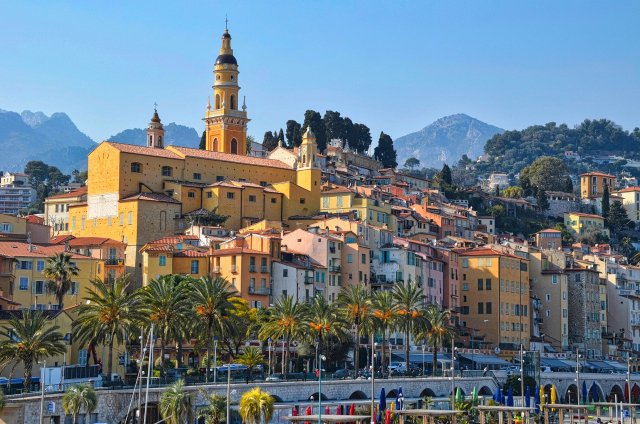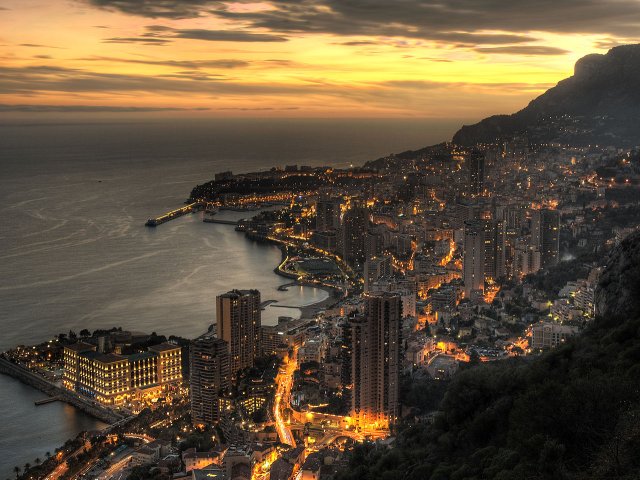If you’re considering booking one of our self-drive French Riviera tours, our favorite months to visit are May, June, September, and October. That being said, this is the warmest region and receives the most sunshine all year round. A French Riviera road trip can therefore also be a good option for those looking for some winter sun!
In the winter (late November to February), the temperature can drop to lower than 5°C/41°F at night with average daily highs of around 14°C/57°F. The days are also shorter, with less than nine hours of daylight in Nice in December.
Although the average maximum summer temperature is around 28°C/82°F, it can get hotter, especially in July and August. In 2023, temperatures reached a high of 34°C/90°F.
Visiting the French Riviera during late spring, early summer, and early fall will help you to avoid extremely hot weather, and are the ideal times to enjoy walks along the beachside promenades, swimming in the Mediterranean, or exploring the region’s charming hilltop villages.
Traveling between April and June or September and October will also help you to avoid the largest tourist crowds in the busiest coastal areas such as Nice, Cannes and Monaco.

©
Pixabay CC0
French Riviera by Month
January and February (winter)
In January you can experience the Monte Carlo International Circus Festival in Monaco.
From mid-February to early March you may attend the colorful Nice Carnival, one of the world's largest carnival events, and the Menton Lemon Festival. These normally take place between mid-February and early March and are great fun!

©
Unsplash CC0
March and April (early spring)
This is a great time to admire the beautiful blossoming trees and flowers in the gardens of Villa Ephrussi de Rothschild at Saint-Jean-Cap-Ferrat or the Exotic Garden of Èze. Both of these gardens also have lovely views of the Mediterranean.
The sea will likely still be too cold to swim in, with an equal number of sunny and cloudy days, and there still won’t be too many tourists.
Be prepared in case there are windy, rainy days during your visit.

©
Pixabay CC0
May (spring)
In mid-May, Cannes and the surrounding areas receive an influx of celebrities and international visitors planning to attend or experience the events of the Cannes Film Festival.
The events of the Monaco Grand Prix, one of the most important Formula 1 races, normally take place over three days during the last week of May.
May can therefore be an exciting time to be in the French Riviera in terms of events - but also busy, especially on the holiday weekends. If you want to be able to escape the hustle and bustle of the busiest areas, we’ll guide you to some lovely quieter places away from the tourist crowds.
These include the Lérins Islands, just a 15-minute boat ride from Cannes, some of our favorite hidden gems and hilltop villages within 30 minutes of your accommodation, and some beautiful hiking areas.
The mild May temperatures make it an ideal time for walking along coastal paths, such as the Sentier du Littoral of Cap Ferrat, or visiting some of the region’s natural parks. The stunning Mercantour National Park is just over an hour’s drive from Nice.

©
Unsplash CC0
June (early summer)
Late June can be a great time to combine a trip to the French Riviera and Provence, as the weather tends to be very pleasant and the lavender fields in the lower hills of Provence are starting to bloom.
On June 21st you can experience the Fête de la Musique (World Music Day), a nationwide music festival. This includes free music events and performances in public spaces and parks all over France.

©
Pixabay CC0
July and August (mid-summer)
These are the hottest and busiest months on the French Riviera, and it’s not our favorite time to visit. The warm sea temperatures (22-26°C/72-77°F) are lovely for swimming and water sports and there will be plenty of people to meet at the lively (paid) beach clubs and seafront restaurants.
The downside is that the whole region, and especially the beaches in the most popular areas, will be very crowded, especially in late July and August. There are tons of tourists and many of the smaller port towns we like to recommend only have one road to get in and out, so these get extremely congested during the peak season.
If you do visit the French Riviera in July and August, leave early (or leave extra time) to get to wherever you need to go, and make dinner reservations at restaurants.
The Tour de France (which starts at the end of June) will pass through the south of France towards the end of July (check the website for the exact dates), so keep in mind that some roads will be closed or particularly busy on those dates.
July is the best time to visit the lavender fields in Provence (to the west of the French Riviera), and some fields are still in bloom in August too. Just be aware that very hot temperatures may make it uncomfortable to be outside for too long at the hottest time of day. If you plan to go hiking or cycling, go first thing in the morning or during the last hours of daylight.
Bastille Day - which marks the prison break that triggered the beginning of the French Revolution in 1789 - is on July 14th, so expect celebrations and fireworks on this day.

©
Unsplash CC0
September and October (late summer/early fall)
The early fall is a wonderful time to visit France. In the French Riviera, the summer crowds will have gone, the sun will still be shining most days, and the sea will still be warm enough to swim in. The weather will normally still be warm, which makes it a lovely time to explore the French Riviera’s small villages, botanical gardens and natural parks.
This is also an excellent opportunity to visit France’s wine regions and witness all the activity at vineyards and wineries during the harvest. Needless to say, the fall colors all over France in late September and October are stunning, and will be particularly appealing to photography enthusiasts.
If you’re interested in boats, the Cannes Yachting festival takes place around Port Canto and Vieux Port for a few days in mid-September.

©
Jonty and Felicity from New Zealand
November and December (winter)
The weather is noticeably cooler on the French Riviera in November, and some of the restaurants, stores, beach clubs and tours close for the winter. However, this is still the sunniest region in France, even in the winter, so it’s still a good option if you’re looking to enjoy some winter sun in Europe.
Attend the Cannes Dance Festival, which takes place every two years at the end of November or the two-week Monte Carlo Jazz Festival, which normally starts around mid-November.
A rainy day can be a good time to experience the glamor of Monte Carlo’s casinos, or to visit some of the museums in the region, such as the Picasso Museum in Antibes or the Chagall Museum in Nice.
The third Thursday in November marks the release of the Beaujolais Nouveau across France. This is a young fruity Gamay wine and although it’s not known for its full body or delicacy, it’s drunk in celebration of the end of the grape harvest. Wherever you are in France on this day, you can expect to find music, events and fireworks.
There are some great ski resorts just a couple of hours’ drive from the French Riviera - with sea views! These include Isola 2000, Auron, Valberg and Gréolières les Neiges. We don’t organize ski trips but if you want to combine it with a driving tour of the French Riviera, we can advise on driving routes and other things to take into consideration.
Finally, of course, December is an opportune time to do some Christmas shopping on the French Riviera! You may like to browse the stores on the Rue d’Antibes in Cannes, or visit the luxury brands that line the Rue Paradis and Avenue de Verdun in Nice. From early December, the main towns along the coast will also have Christmas markets - a great opportunity to pick up some souvenirs.

©
In summary, the best time to visit the French Riviera is in late April, May, June, September, and October. These months offer a perfect balance of pleasant weather, manageable crowds, and a wide range of activities.
If you like the idea of driving the French Riviera, we invite you to contact us with your questions or your wishlist. We - Emilie, Laura and Clelia - would love to help plan your dream trip to France!
FAQs
What are the best cities to visit in the French Riviera?
The best French Riviera cities to visit, including some of the larger towns, are: Nice, Monte Carlo, Cannes, Grasse, Antibes, and Menton.
You might also like to visit the port city of Toulon, which has more of a local feel and isn't as touristy.












